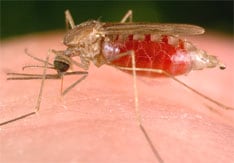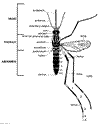Anopheles Mosquitoes
Malaria is transmitted among humans by female mosquitoes of the genus Anopheles. Female mosquitoes take blood meals to carry out egg production, and such blood meals are the link between the human and the mosquito hosts in the parasite life cycle. The successful development of the malaria parasite in the mosquito (from the "gametocyte" stage to the "sporozoite" stage) depends on several factors. The most important is ambient temperature and humidity (higher temperatures accelerate the parasite growth in the mosquito) and whether the Anopheles survives long enough to allow the parasite to complete its cycle in the mosquito host ("sporogonic" or "extrinsic" cycle, duration 10 to 18 days). Differently from the human host, the mosquito host does not suffer noticeably from the presence of the parasites.General Information

ap of the world showing the distribution of predominant malaria vectors
Larger Picture
Larger Picture
Geographic Distribution
Anophelines are found worldwide except Antarctica. Malaria is transmitted by different Anopheles species, depending on the region and the environment.Anophelines that can transmit malaria are found not only in malaria-endemic areas, but also in areas where malaria has been eliminated. The latter areas are thus constantly at risk of re-introduction of the disease.

Anopheles freeborni mosquito pumping blood
Larger Picture
Larger Picture

Sequential images of the mosquito taking its blood meal
Life Stages
Like all mosquitoes, anophelines go through four stages in their life cycle: egg, larva, pupa, and adult. The first three stages are aquatic and last 5-14 days, depending on the species and the ambient temperature. The adult stage is when the female Anopheles mosquito acts as malaria vector. The adult females can live up to a month (or more in captivity) but most probably do not live more than 1-2 weeks in nature.
Top: Anopheles Egg; note the lateral floats.
Bottom: Anopheles eggs are laid singly.
Bottom: Anopheles eggs are laid singly.
Eggs
Adult females lay 50-200 eggs per oviposition. Eggs are laid singly directly on water and are unique in having floats on either side. Eggs are not resistant to drying and hatch within 2-3 days, although hatching may take up to 2-3 weeks in colder climates.Larvae
Mosquito larvae have a well-developed head with mouth brushes used for feeding, a large thorax, and a segmented abdomen. They have no legs. In contrast to other mosquitoes, Anopheles larvae lack a respiratory siphon and for this reason position themselves so that their body is parallel to the surface of the water.Larvae breathe through spiracles located on the 8th abdominal segment and therefore must come to the surface frequently.

Anopheles Larva. Note the position, parallel to the water surface.
Larvae develop through 4 stages, or instars, after which they metamorphose into pupae. At the end of each instar, the larvae molt, shedding their exoskeleton, or skin, to allow for further growth.



Larvae of Anopheles gambiae, the major malaria vector in Africa, can breed in diverse habitats. Three habitats are shown from left to right: tire tracks, rice fields, and irrigation water.
The larvae occur in a wide range of habitats but most species prefer clean, unpolluted water. Larvae of Anopheles mosquitoes have been found in fresh- or salt-water marshes, mangrove swamps, rice fields, grassy ditches, the edges of streams and rivers, and small, temporary rain pools. Many species prefer habitats with vegetation. Others prefer habitats that have none. Some breed in open, sun-lit pools while others are found only in shaded breeding sites in forests. A few species breed in tree holes or the leaf axils of some plants.

Anopheles Pupa
Pupae
The pupa is comma-shaped when viewed from the side. The head and thorax are merged into a cephalothorax with the abdomen curving around underneath. As with the larvae, pupae must come to the surface frequently to breathe, which they do through a pair of respiratory trumpets on the cephalothorax. After a few days as a pupa, the dorsal surface of the cephalothorax splits and the adult mosquito emerges.The duration from egg to adult varies considerably among species and is strongly influenced by ambient temperature. Mosquitoes can develop from egg to adult in as little as 5 days but usually take 10-14 days in tropical conditions.

Anopheles Adults. Note (bottom row) the typical resting position.
Adults
Like all mosquitoes, adult anophelines have slender bodies with 3 sections: head, thorax and abdomen.The head is specialized for acquiring sensory information and for feeding. The head contains the eyes and a pair of long, many-segmented antennae. The antennae are important for detecting host odors as well as odors of breeding sites where females lay eggs. The head also has an elongate, forward-projecting proboscis used for feeding, and two sensory palps.
The thorax is specialized for locomotion. Three pairs of legs and a pair of wings are attached to the thorax.
The abdomen is specialized for food digestion and egg development. This segmented body part expands considerably when a female takes a blood meal. The blood is digested over time serving as a source of protein for the production of eggs, which gradually fill the abdomen.
Anopheles mosquitoes can be distinguished from other mosquitoes by the palps, which are as long as the proboscis, and by the presence of discrete blocks of black and white scales on the wings. Adult Anopheles can also be identified by their typical resting position: males and females rest with their abdomens sticking up in the air rather than parallel to the surface on which they are resting.
Adult mosquitoes usually mate within a few days after emerging from the pupal stage. In most species, the males form large swarms, usually around dusk, and the females fly into the swarms to mate.

Female Anopheles dirus feeding
The cycle repeats itself until the female dies. Females can survive up to a month (or longer in captivity) but most probably do not live longer than 1-2 weeks in nature. Their chances of survival depend on temperature and humidity, but also their ability to successfully obtain a blood meal while avoiding host defenses.
Factors Involved in Malaria Transmission and Malaria Control
Understanding the biology and behavior of Anopheles mosquitoes can help understand how malaria is transmitted and can aid in designing appropriate control strategies. Factors that affect a mosquito's ability to transmit malaria include its innate susceptibility to Plasmodium, its host choice, and its longevity. Factors that should be taken into consideration when designing a control program include the susceptibility of malaria vectors to insecticides and the preferred feeding and resting location of adult mosquitoes.Preferred Sources for Blood Meals
One important behavioral factor is the degree to which an Anopheles species prefers to feed on humans (anthropophily) or animals such as cattle (zoophily). Anthrophilic Anopheles are more likely to transmit the malaria parasites from one person to another. Most Anopheles mosquitoes are not exclusively anthropophilic or zoophilic. However, the primary malaria vectors in Africa, An. gambiae and An. funestus, are strongly anthropophilic and, consequently, are two of the most efficient malaria vectors in the world.Life Span
Once ingested by a mosquito, malaria parasites must undergo development within the mosquito before they are infectious to humans. The time required for development in the mosquito (the extrinsic incubation period) ranges from 10 to 21 days, depending on the parasite species and the temperature. If a mosquito does not survive longer than the extrinsic incubation period, then she will not be able to transmit any malaria parasites.It is not possible to measure directly the life span of mosquitoes in nature. But indirect estimates of daily survivorship have been made for several Anopheles species. Estimates of daily survivorship of An. gambiae in Tanzania ranged from 0.77 to 0.84 meaning that at the end of one day between 77% and 84% will have survived. (Charlwood et al., 1997, Survival And Infection Probabilities of Anthropophagic Anophelines From An Area of High Prevalence of Plasmodium falciparum in Humans, Bulletin of Entomological Research, 87, 445-453).
Assuming this is constant through the adult life of a mosquito, less than 10% of female An. gambiae would survive longer than a 14-day extrinsic incubation period. If daily survivorship increased to 0.9, over 20% of mosquitoes would survive longer than a 14-day extrinsic incubation period. Control measures that rely on insecticides (e.g., indoor residual spraying) may actually impact malaria transmission more through their effect on adult longevity than through their effect on the population of adult mosquitoes.
